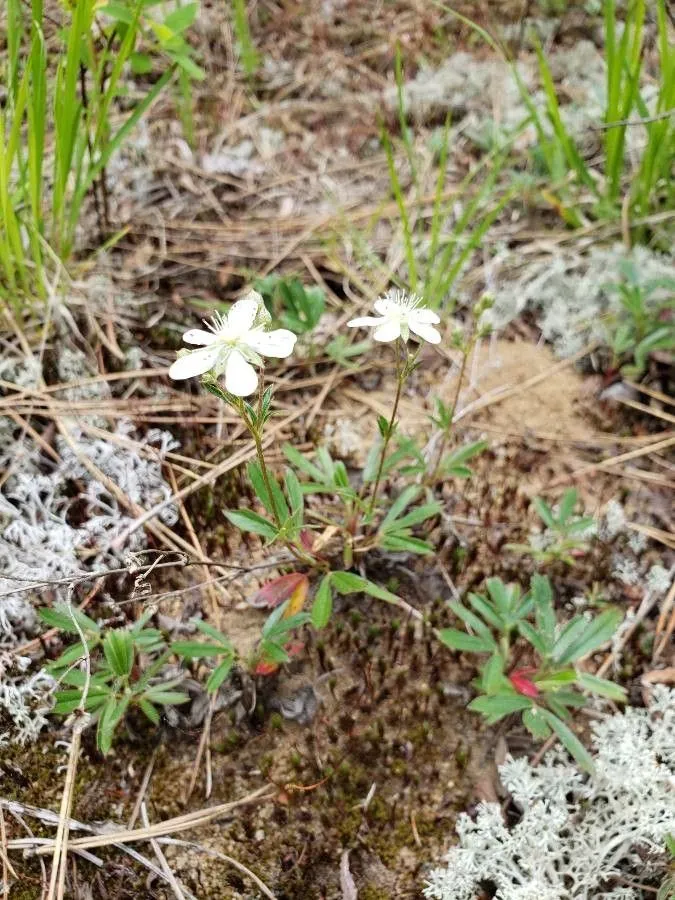
Author: (L.) Salisb.
Bibliography: Trans. Linn. Soc. London 8: 305 (1807)
Year: 1807
Status: accepted
Rank: species
Genus: Coptis
Vegetable: False
Observations: E. Siberia to Russian Far East, N. & C. Japan, Subarctic America to NC. & NE. U.S.A.
American goldthread, scientifically known as Coptis trifolia, is a perennial herbaceous plant belonging to the Ranunculaceae family. This small, delicate plant is notable for its distinctive three-parted leaves, which provide the trifolia part of its name.
Native to a broad range of regions, American goldthread can be found in habitats stretching from Eastern Siberia to the Russian Far East, as well as in northern and central Japan. In North America, its range extends from subarctic regions down to the northeastern and northcentral United States. Its widespread presence across these diverse biomes is indicative of its adaptability and hardiness in cooler climates.
This plant was first cataloged in detail in 1807, and its description can be found in the eighth volume of the Transactions of the Linnean Society of London. The scientific classification was attributed to the eminent botanist Richard Anthony Salisbury, who consolidated its nomenclature.
American goldthread is easily recognizable in the wild by its glossy, dark green leaves and its slender, thread-like yellow underground rhizomes, which give the plant its common name due to their goldish hue. These rhizomes have traditionally been used by indigenous peoples for their medicinal properties, often to treat mouth sores and digestive issues.
As a member of the buttercup family, the American goldthread shares numerous botanical characteristics with its relatives, including the typical alkaloids expected in this family which have often drawn interest for their therapeutic potentials.
Typically found in moist, shaded forest understories, bogs, and mossy areas, Coptis trifolia prefers acidic soils and thrives best in less disturbed habitats where it can enjoy consistent moisture levels which mimic the cool, damp environments of its native range. It plays a role in the local ecosystem, contributing to the plant diversity and stability of the forest floor it inhabits.
In summary, the American goldthread (Coptis trifolia) is a fascinating plant with a rich historical background and ecological significance, notable for its distinctive leaves and underground rhizomes that have caught the interest of both botanists and herbalists over centuries.
Eng: american goldthread, canker-root, goldthread, threeleaf goldthread, goldenroot, savoyana, three-leaved goldthread, yellow snakeroot
Swe: polarkoptis
Fra: savoyane, coptide du groenland, coptide savoyane, sabouillane, sibouillane
En: American goldthread, Canker-root, Goldthread, Threeleaf goldthread, Three-Leaf Goldthread, Goldenroot, Savoyana, Three-leaved goldthread, Yellow snakeroot
Ar: كوبتس تريفوليا
Fr: Savoyane, Coptide du Groenland, Coptide savoyane, Sabouillane, Sibouillane
De: Dreiblättriger Goldfaden
Sv: Polarkoptis
Taken Apr 24, 2021 by Philippe St-Pierre (cc-by-sa)
Taken Oct 12, 2022 by casey manera (cc-by-sa)
Taken Apr 18, 2022 by Ron Banerjee (cc-by-sa)
Taken Jan 1, 2022 by Mrc Pase (cc-by-sa)
Taken Feb 28, 2022 by Stefano Lazzaretti (cc-by-sa)
Taken Jun 22, 2019 by Bianca Legault (cc-by-sa)
Taken Jun 25, 2021 by Jason lester (cc-by-sa)
Taken May 21, 2014 by EOL − Susan Elliott (cc-by-nc)
Taken Mar 25, 2021 by Mátyás Hegedüs (cc-by-sa)
Taken Sep 11, 2021 by Benny J (cc-by-sa)
Taken Jul 28, 2015 by EOL − Clayton D’Orsay (cc-by-nc)
Taken Jan 1, 1900 by EOL − Howard, R.A. (cc-by-nc-sa)
Taken Jul 19, 2015 by EOL − Charlie Hohn (cc-by-nc)
Taken Jun 28, 2015 by EOL − Charlie Hohn (cc-by-nc)
Taken Jun 22, 2019 by Bianca Legault (cc-by-sa)
Taken Jan 22, 2016 by EOL − leannewallisbiologist (cc-by-nc)
Taken Apr 11, 2016 by EOL − Denis Doucet (cc-by-nc-sa)
Taken Dec 9, 2014 by EOL − Dan Nydick (cc-by-nc)
Taken Jan 17, 2014 by EOL − Sarah Carline (cc-by-nc)
Taken Oct 27, 2015 by EOL − bendingtree (cc-by-nc)
Taken Sep 1, 2014 by EOL − Laura (cc-by-nc)
Growth habit: Forb/herb
Family: Myrtaceae Author: (F.Muell.) K.D.Hill & L.A.S.Johnson Bibliography: Telopea 6: 402 (1995) Year: 1995 Status:…
Family: Rubiaceae Author: Pierre ex A.Froehner Bibliography: Notizbl. Bot. Gart. Berlin-Dahlem 1: 237 (1897) Year:…
Family: Sapindaceae Author: Koidz. Bibliography: J. Coll. Sci. Imp. Univ. Tokyo 32(1): 38 (1911) Year:…
Family: Asteraceae Author: A.Gray Bibliography: Pacif. Railr. Rep.: 107 (1857) Year: 1857 Status: accepted Rank:…
Family: Fabaceae Author: Medik. Bibliography: Vorles. Churpfälz. Phys.-Ökon. Ges. 2: 398 (1787) Year: 1787 Status:…
Family: Aspleniaceae Author: (Cav.) Alston Bibliography: Bull. Misc. Inform. Kew 1932: 309 (1932) Year: 1932…